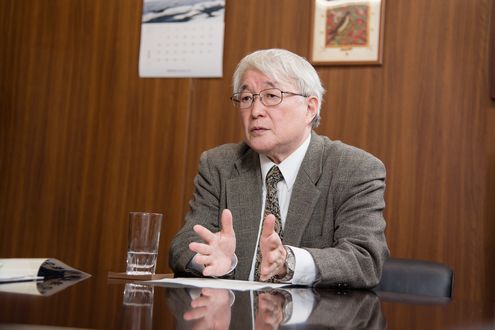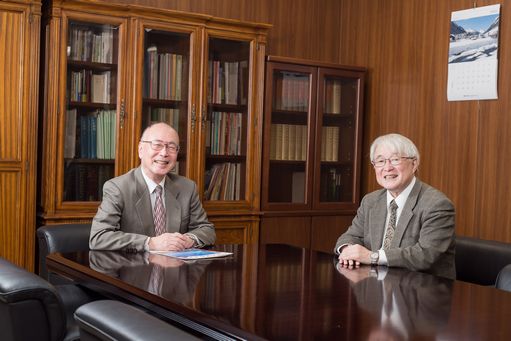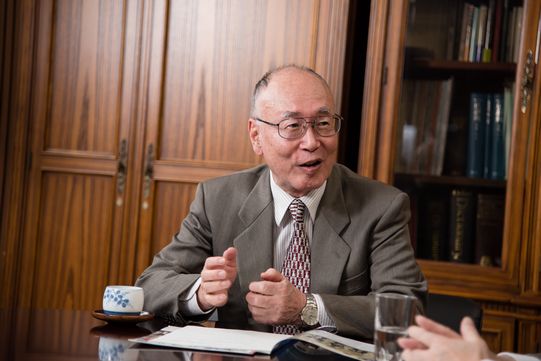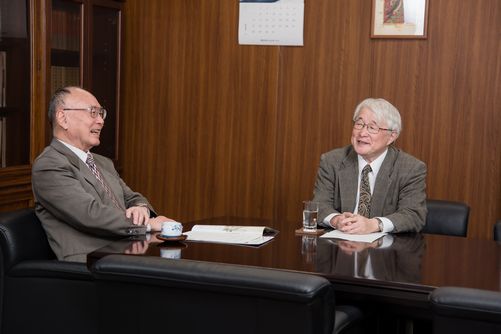Interview Series “Yukinori Takubo, New Director-General, National Institute for Japanese Language and Linguistics (NINJAL)”

Professor Takubo came into office as director-general of NINJAL in October 2017, following the retirement of Professor Tarō Kageyama, who had served as director-general for eight years since 2009. Kageyama’s leadership coincided with the time when the institute made the transition from an independent administrative institution to its current status as an inter-university research institute corporation.
In 2018, NINJAL celebrates the 70th year since its founding. The institute has been engaged in studying and documenting the state of the Japanese language as it is used in various regions and over the course of history, as well as in organizing materials and making them available in the form of databases. Tachimoto, president of the National Institutes for the Humanities (NIHU) asked the new director-general about his ambitions for accumulating and improving basic research over the long-term as well as what kind of shorter-term results he hopes to show in the course of NINJAL’s six-year plan period between 2016 and 2021.
Interviewer: Narifumi Tachimoto
President, National Institutes for the Humanities
1. Ambitions and Prospects for the Institute’s Six-year Plan
(Tachimoto) NINJAL went through the difficult transition from an independent administrative institution to an inter-university research institute corporation. I see those eight years as a time during which NINJAL became an institute for language and linguistics research of which Japan can be proud. How do you see the Institute’s standing today?
(Takubo) Indeed, NINJAL accomplished a great deal during its time as an independent administrative institution (2001–2009), and among the achievements of that period were a number that stood out in an international context. Unfortunately, however, the institute was not able to project those achievements for appreciation outside Japan. When former director-general Kageyama took NINJAL’s leadership, he was determined to remedy that situation. He himself demonstrated high English proficiency and a large number of English publications came out at the institute under his leadership, greatly contributing to NINJAL’s international reputation.

(Tachimoto) Four more years remain in the current six-year plan period, which began in 2016. Please share with us your ambitions for what NINJAL can achieve during these years.
(Takubo) NINJAL celebrates its 70th anniversary in December 2018 and in October next year its tenth anniversary since becoming an inter-university research institute. So we are taking the opportunities of these 70th and 10th anniversaries to hold a number of events over a period of about six months. We are currently in the process of plans that will represent the summation of NINJAL up until now, including its time as an independent administrative institution, and also chart its path forward into the future.
(Tachimoto) So you hope to carry on Kageyama’s programs laid out in the six-year plan? And will this approach be reflected in the events to commemorate the founding of NINJAL?
(Takubo)Yes. I have been sitting in the steering committee of NINJAL’s six-year plan and the theme that will run through all our activities during this period will be “Data Driven Language Research.” This theme will be the overarching topic which current projects across many different fields and research specialties will need to refer to. At the same time, from among those projects, we will select a few that have particular potential for development and simultaneously draw up programs for the next six-year plan starting 2022.
2. NINJAL and Linguistics Research
(Tachimoto) I am sure those ambitions will guide your leadership at NINJAL, but I would like to ask you about a difference in the mission of the institute between the time it was an independent administrative institution and what it is today as an inter-university research institute. I believe it is the difference between “Kokugogaku” (Japanese linguistics) and “Gengogaku” (linguistics), but could you explain that to us? I realize that the institute continues to call itself the National Institute for Japanese Language and Linguistics (Kokuritsu Kokugo Kenkyūjo), in Japanese using the word “Kokugo.”
(Takubo) Yes, I suspect that former director-general Kageyama wanted to change the name to the Gengogaku Kenkyujo (National Institute for Linguistics Research). “Kokugo” ends up sounding a little confining.
The Nihongo Gakkai (Society for Japanese Linguistics), for example, was previously the Kokugo Gakkai. There was a disagreement between members who sought to relativize the Japanese language in the context of world languages—the advocates of calling it the Nihongo Gakkai—and those who emphasized “kokugo,” based on philological research, urging that it remain the Kokugo Gakkai. A vote among the members was held and the name was changed to Nihongo Gakkai in 2004. I have heard that a number of members left the society because they could not agree with the idea of relativizing the Japanese language.
What should be done about NINJAL’s name, I do not quite know what to say, as I am not part of that particular debate.
(Tachimoto) NINJAL conducts a wide variety of surveys and it has acquired an immense wealth of data, part of which I believe is made available in the form of various corpora. Could you describe to us the research going on at NINJAL?
(Takubo) Take, for example NINJAL’s 1960s research as found in the book Hanashi kotoba no bunkei 1 (Research of Sentence Patters in Colloquial Japanese (1)), “Kokuritsu Kokugo Kenkyūjo hōkoku” 18 (1960). That was a very theoretical work, in which Professor Fujio Minami, for example, presented his original theory about the structure of Japanese.1 Fifty years have passed since then but research is still going on based on his idea about the structure of Japanese. And finally now world linguistic studies are catching up with his research. Today, the very lively linguistic research that is going on based on the theory of hierarchical structure of Japanese sentences, too, is based on the theoretical research accumulated by Minami as discussed in Hanashi kotoba no bunkei 2 (Research of Sentence Patters in Colloquial Japanese (2)) “Kokuritsu Kokugo Kenkyūjo hōkoku” 23 (1963), and is being studied in Japan and overseas. I myself have published several articles on that subject.
(Tachimoto) I am indeed eager to see the ways that NINJAL’s 70-year history and traditions can be built upon and made better known under your leadership.

(Takubo) Yes, we have, for example, the numerous language maps including dialect grammar maps and vocabulary maps compiled as a result of nationwide surveys led by Professors Takeshi Shibata2 and Tokugawa Munemasa.3 We are now digitalizing the maps, and these are sure to provide valuable new materials for comparative linguistics research. There are now studies that can use such materials to explore the historical relationship between languages, the language family, using algorithms originating from modern biology research. These studies could not be possible without NINJAL’s accumulated data. The data we have collected over the years is tremendous in quantity.
(Tachimoto) That’s right, and it also goes way back in time as well. Even from the viewpoint of a non-specialist in this field like me, it is really impressive.
(Takubo) But in fact we presently only have but a very small part of all our data available to the public. We are still in the process of organizing it.
(Tachimoto) From about when has NINJAL been digitizing its resources?
(Takubo) Oh, it has been going on since the beginning. From the early phase of its 70-year history, computers and statistics were used in the tallying of the data. Since very early on NINJAL has not only hired science-trained experts in computer science to support its digitalizing projects, but integrated informatics, statistics, and other fields of science into its humanities-based endeavors.
(Tachimoto) So you would say that forms a firm footing for the current projects you have in informatics and other collaborative research?
(Takubo) Yes, that’s right. Joint research with the Institute of Statistical Mathematics has been going on at NINJAL from a long time ago. We work with them in the planning of dialect surveys and in the processing of the data collected.
(Tachimoto) What directions do you see for dialect research at NINJAL from now on?
(Takubo) In dialect research, we basically treat a dialect as a discrete language and record data. Japan has thousands of dialects, and our approach is to treat each one as a distinct language system; that is what makes our approach different from so-called dialectology.
Dialectology adopts a comparative language approach, so it begins with something regarded as standard Japanese and looks at what differs from the standard. At NINJAL—whether this is what you would call the linguistic approach, I am not sure—but that is the way the younger generation is being trained. For example, if you do field study in a particular area, you record the language in that locale as a whole. You create a dictionary, write down the grammar, and create texts. Then all the documentation is then digitalized. Audio and video recordings are also made, and the language (dialect) is thus recorded as a whole.
Also, one aspect of dialect studies is the concern with endangered dialects and languages. So sometimes research doesn’t just stop with recording the language. If the local community wants to revive the dialect, the researchers may study methods by which they could assist in that process.
NINJAL’s mission today, in fact, is shifting its weight over to the latter kind of research. Younger-generation linguists are trained not so much in dialectology as in linguistics. So at the same time as conducting systematic recording of language, there are quite a few of them who are working with communities to learn how those dialects can be reinvigorated.
3. NINJAL and Japanese Language Education
(Tachimoto) Of course, there are many universities and other institutions engaged in research on Japanese language education and teaching methods. As an inter-university research institute, what are NINJAL’s main activities in this area?

(Takubo) What we are doing now as far as Japanese-language education is concerned, rather than study of teaching methods, is working to understand the features of Japanese as it is spoken by non-Japanese and making available the findings of the research to practitioners in Japanese language education.
Another project we have, deals not with Japanese as it is taught in textbooks, but focuses on real Japanese as we actually speak it, and the findings are utilized in Japanese language education. This is a form of long-term basic research aimed at learning about Japanese as spoken by non-Japanese, what kinds of Japanese non-Japanese should learn, and what aspects of Japanese are difficult for non-Japanese when they study the language. These are topics that are probably not dealt with much outside NINJAL. Those engaged in actually teaching Japanese do not have the leeway to study such issues; teaching Japanese is quite an exhausting profession.
(Tachimoto) You yourself were involved in teaching Japanese in South Korea, I believe.
(Takubo) Yes, I taught Japanese for two years in South Korea and eight years at Kobe University—a total of ten years. In teaching Japanese in Japan, we cannot use a foreign language. Even if we have Chinese, American, and Indonesian students in our classes, a single tutor will not be able to explain in Chinese, English, and Indonesian. So we have to use Japanese in teaching the language. So how do you get across the meaning of the words and phrases students have not yet learned? Some teachers have come up with very skillful ways of doing so.
(Tachimoto) That’s a very tough challenge.
(Takubo) We are currently considering a new joint research project with the National Institute for Physiological Sciences (NIPS) in Okazaki, Aichi. It is said that communication works, not just because of words but because of understandings established before any words are spoken, that is the existence of some kind of rapport (such as relations of mutual trust) among the participants. We are now considering whether we can work on the mechanisms of this with a brain scientist at NIPS.
4. Direction as an Inter-University Research Institute

(Tachimoto) I see. That is the kind of joint research with research institutes outside of the NIHU umbrella that is increasingly being called for, but what is your position regarding collaboration with other NIHU institutes?
(Takubo) We are still at the stage of exploring to what extent we can engage in such collaboration. We do now already have a number of ways we cooperate with the National Institute for Japanese Literature (NIJL). Some scholars at NINJAL work in bibliographical research, so we have an arrangement for direct access from the NINJAL database to images in NIJL’s database. It also looks as if greater cooperation with the International Research Center for Japanese Studies (Nichibunken) in Kyoto would be beneficial as well.
(Tachimoto) Yes, NINJAL-Nichibunken collaboration was something I was just about to ask you about.
(Takubo) Prior to taking up my present post at NINJAL, I attended a research group called “Debates on the Origins of the Japanese Language: Light and Shadow in the History of Japanese Linguistics.”
(Tachimoto) Who was the organizer of the seminar?
(Takubo) It was Professor Toshiki Osada.4 He had previously been at the Research Institute for Humanity and Nature (RIHN) in Kyoto and had set up a research project going on in collaboration with RIHN. Then some of my former students from when I was teaching at Kyoto University (2000–2016) started a study group at RIHN, and they created what they call the Descriptive Linguistics Study Group (Kijutsu Gengogaku Kenkyukai) and hold seminars on not just Japanese but description of various endangered languages. With the cooperation of RIHN professors, they keep that seminar going even now.
(Tachimoto) That is the kind of dynamic interaction among the inter-university research institutes we very much like to see.
(Takubo) I also think we can benefit from cooperation with the National Museum of Ethnology (Minpaku), in Osaka. Lately a few specialists in language and linguistics have joined the institute.
(Tachimoto) The inter-university research institutes also have the mission, I think, to not only pursue links with universities and institutes but also to lead universities in ground-breaking research projects. In the case of NINJAL, how can NINJAL take the lead in such research projects with universities that have linguistics departments or related courses? Have you thought about that sort of thing?
(Takubo) Right now, NINJAL works with a total of about 650 scholars, including its core faculty, members of joint research projects, and research collaborators, and more than half of these are researchers based at other universities. So for each research project we undertake, we are involving scholars from many different fields and from other universities. For example, NINJAL Professor Nobuko Kibe has students and young scholars coming from across the nation doing surveys, getting training in field survey work as well as engaging in various studies of endangered dialects and languages. This kind of project is something that would be difficult for any one university to undertake.
(Tachimoto) NINJAL has amassed a data archive of which we can be justly proud. I look forward to the ways you will be able to make its advantages and usefulness known to the world. Thank you for joining me for this conversation.
1 Minami Fujio, former director of the Center for Japanese Language Education, NINJAL. His publications include Gendai nihongo kenkyū (Studies in Modern Japanese Language; Sanseidō, 1997); Keigo (Honorifics; Iwanami Shoten, 1987); Gendai nihongo no kōzō (The Structure of Modern Japanese; Taishūkan Shoten, 1974).
2 Shibata Takeshi, Professor Emeritus, University of Tokyo, Professor Emeritus Saitama University. As a researcher at NINJAL 1949–1964, he undertook surveys for Japanese language maps, and published many reports of his geographical linguistic research including Nihon no hōgen (Japanese Dialects; Iwanami Shoten, 1958) and Shin meikai kokugo jiten (The New Clear Japanese Dictionary; Sanseidō)
3 Tokugawa Munemasa was former Professor of Gakushuin University. He joined the Itoigawa survey led by Professor Shibata Takeshi and took part in the compilation of the maps of Japanese language. Among his publications are Nihonjin no hōgen (Dialects of Japanese; Chikuma Shobō, 1978) and Nihongo kenkyū to kyōiku no michi (The Path of Japanese-Language Research and the Path of Education; Meiji Shoin, 1994).
4 Osada Toshiki: Professor Emeritus of the Research Institute for Humanity and Nature and Visiting Professor at the International Research Center for Japanese Studies. Specialist in languages, especially the Munda language of India. Among his publications are Shin Indo-gaku (New Studies of India; Kadokawa Gakugei Shuppan, 2002) and Indasu bunmei no nazo: Kodai bunmei shinwa o minaosu (Riddles of Indian Civilization: A New Look at the Myth of Ancient Civilization; Kyōto Daigaku Shuppankai, 2013).
